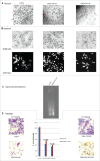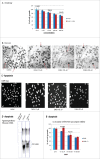Differential biological effects of dehydroepiandrosterone (DHEA) between mouse (B16F10) and human melanoma (BLM) cell lines
- PMID: 29484102
- PMCID: PMC5821161
- DOI: 10.1080/19381980.2017.1389360
Differential biological effects of dehydroepiandrosterone (DHEA) between mouse (B16F10) and human melanoma (BLM) cell lines
Abstract
Dehydroepiandrosterone (DHEA) is a weak androgen and had been shown to have anti-cancer, anti-adipogenic and anti-inflammatory effects on mouse and other rodent models, but not on humans, suggesting a systemic level difference between mouse and human. Our previous study on DHEA biological functions involving a variety of cell lines, suggested that the functional differences between mouse and human existed even at the cellular level. Hence, using mouse and human melanoma cell models, in-vitro effects of DHEA on cell growth, mechanism of cell death and mechanism of DHEA action were studied. Results indicated a differential biological effects of DHEA between mouse and human melanoma cell lines. These in-vitro studies also suggested that the differential biological effects observed between these two cell lines could be due to the difference in the way DHEA was processed or metabolized inside the cell.
Keywords: Bicalutamide; DHEA; androgen receptor; apoptosis; autophagy; human melanoma (BLM) cell line; mouse melanoma (B16F10) cell line.
Figures





Similar articles
-
Dehydroepiandrosterone inhibits B16 mouse melanoma cell growth by induction of differentiation.Anticancer Res. 1995 Mar-Apr;15(2):427-31. Anticancer Res. 1995. PMID: 7763017
-
Dehydroepiandrosterone inhibits the proliferation and induces the death of HPV-positive and HPV-negative cervical cancer cells through an androgen- and estrogen-receptor independent mechanism.FEBS J. 2009 Oct;276(19):5598-609. doi: 10.1111/j.1742-4658.2009.07253.x. Epub 2009 Aug 21. FEBS J. 2009. PMID: 19702826
-
Genome-wide analysis of DHEA- and DHT-induced gene expression in mouse hypothalamus and hippocampus.J Steroid Biochem Mol Biol. 2009 Apr;114(3-5):135-43. doi: 10.1016/j.jsbmb.2009.01.015. Epub 2009 Feb 3. J Steroid Biochem Mol Biol. 2009. PMID: 19429443
-
Is there a receptor for dehydroepiandrosterone or dehydroepiandrosterone sulfate?Semin Reprod Med. 2004 Nov;22(4):289-98. doi: 10.1055/s-2004-861546. Semin Reprod Med. 2004. PMID: 15635497 Review.
-
Dehydroepiandrosterone Research: Past, Current, and Future.Vitam Horm. 2018;108:1-28. doi: 10.1016/bs.vh.2018.02.002. Epub 2018 Mar 16. Vitam Horm. 2018. PMID: 30029723 Review.
Cited by
-
G6PD promotes cell proliferation and dexamethasone resistance in multiple myeloma via increasing anti-oxidant production and activating Wnt/β-catenin pathway.Exp Hematol Oncol. 2022 Oct 21;11(1):77. doi: 10.1186/s40164-022-00326-6. Exp Hematol Oncol. 2022. PMID: 36271440 Free PMC article.
-
A fingerprint of 2-[18F]FDG radiometabolites - How tissue-specific metabolism beyond 2-[18F]FDG-6-P could affect tracer accumulation.iScience. 2023 Oct 6;26(11):108137. doi: 10.1016/j.isci.2023.108137. eCollection 2023 Nov 17. iScience. 2023. PMID: 37867937 Free PMC article.
-
The Multiple Roles of Glucose-6-Phosphate Dehydrogenase in Tumorigenesis and Cancer Chemoresistance.Life (Basel). 2022 Feb 12;12(2):271. doi: 10.3390/life12020271. Life (Basel). 2022. PMID: 35207558 Free PMC article. Review.
-
Investigation of Physiological Effects Induced by Dehydroepiandrosterone in Human Endothelial Cells and Ovarian Cancer Cell Line.Turk J Pharm Sci. 2021 Apr 20;18(2):185-191. doi: 10.4274/tjps.galenos.2020.58827. Turk J Pharm Sci. 2021. PMID: 33902257 Free PMC article.
References
-
- Symington T, Duguid WP, Davidson JN. Effect of exogenous corticotropin on the histochemical pattern of the human adrenal cortex and a comparison with the changes during stress. JCEM, 1956;16:580–98. - PubMed
-
- Kalimi M, Regelson M (Eds) The biological role of dehydroepiandrosterone (DHEA). New York: Walter de gruyter; 1990.
-
- Baulieu EE. Dehydroepiandrosterone: A fountain of youth? JCEM. 1996;81(9):3147–51. - PubMed
LinkOut - more resources
Full Text Sources
Other Literature Sources
